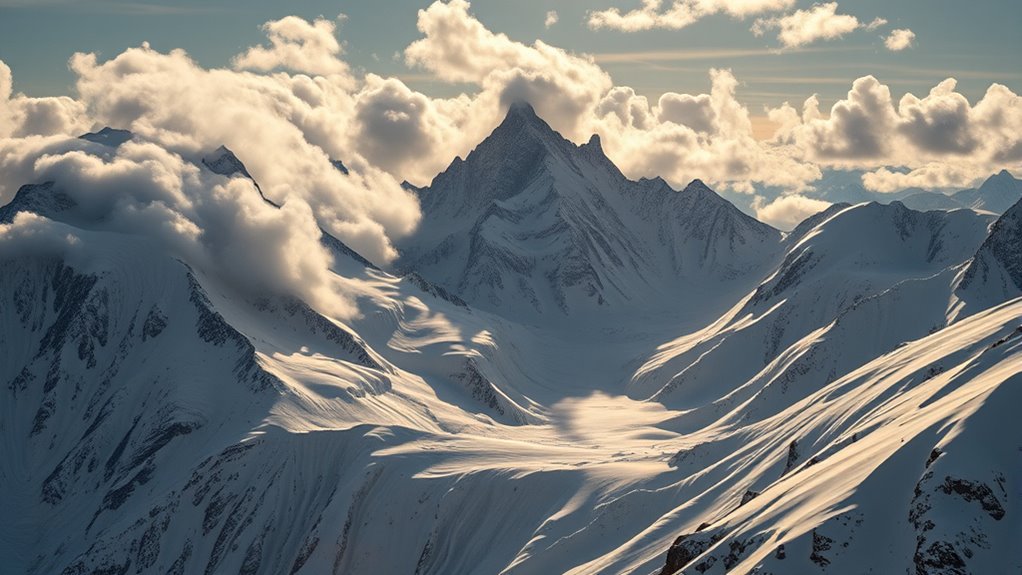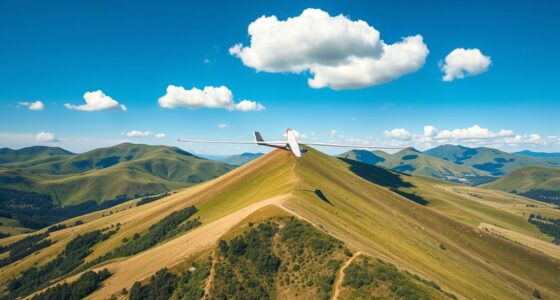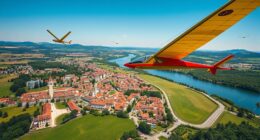In mountain meteorology, you’ll notice that terrain markedly influences airflow, creating downslope winds, lee waves, and rotor turbulence. Downslope winds happen when cold, dense air flows rapidly down the slopes, often bringing clear, windy conditions. Lee waves form as airflow over ridges causes oscillating wave patterns on the leeside, which can lead to turbulence. Rotors are dangerous, swirling vortices that develop near mountains, affecting aviation and stability. Understanding these phenomena helps you anticipate mountain weather more accurately; exploring further reveals how these processes connect.
Key Takeaways
- Downslope winds occur when cold, dense air flows rapidly down mountain slopes during clear, calm conditions, often causing strong surface winds.
- Lee waves form when stable airflow over mountains creates oscillations and wave patterns on the downwind side.
- Rotor turbulence manifests as rotating, turbulent eddies near the mountain lee, impacting aviation and surface conditions.
- Terrain-induced airflow phenomena like lee waves and rotors are driven by airflow over and around mountain obstacles, influenced by stability and wind speed.
- Understanding these processes is essential for accurate weather prediction, aviation safety, and managing mountain environmental conditions.

Mountain meteorology explores how complex terrain influences weather patterns and atmospheric processes. When you’re in mountainous regions, you’ll notice that the terrain doesn’t just shape the landscape—it actively affects the local weather. For instance, valley breezes and mountain inversions are two key phenomena that demonstrate how terrain interacts with atmospheric conditions. During the day, the sun heats up the slopes, causing the warm air to rise and creating a breeze that flows down into the valley—this is called a valley breeze. It’s a natural cycle driven by temperature differences, and it plays a significant role in local weather, especially in narrow valleys where the airflow can be quite strong and persistent.
At night, the process reverses. The slopes cool rapidly after sunset, and the cooler, denser air begins to descend into the valley, generating a mountain breeze. This diurnal cycle influences temperature distribution and can impact everything from local ecosystems to human activities. But terrain-related phenomena aren’t limited to breezes; mountain inversions are equally significant. During clear, calm nights, cold air often pools in the valleys, trapped beneath a warmer layer aloft—this creates a mountain inversion. These inversions can lead to fog formation, poor air quality, and temperature inversions that persist for hours or even days, especially in winter. As a result, air pollution can become trapped in valleys, creating health hazards and affecting local climate.
Understanding valley breezes and mountain inversions is essential if you’re studying or working in mountainous areas. These phenomena influence weather forecasting, aviation safety, and environmental conditions. For example, valley breezes can enhance local wind speeds, affecting drone or aircraft operations, while mountain inversions can lead to smog buildup, impacting air quality. Recognizing these patterns helps you anticipate weather changes and understand how terrain shapes atmospheric behavior. They also set the stage for more complex mountain meteorological phenomena, such as downslope winds, lee waves, and rotor turbulence. Each of these processes is driven by the same fundamental principle: terrain modifies airflow and temperature distribution, creating a dynamic and often unpredictable environment.
Frequently Asked Questions
How Do Mountain Winds Affect Local Weather Patterns?
Mountain winds markedly influence your local weather patterns by creating valley breezes that warm the area during the day and mountain chill that cools it at night. As the wind flows downslope, it can bring cooler air, affecting temperature and humidity. These winds also trigger phenomena like lee waves and rotor turbulence, which can impact local weather stability and lead to sudden changes, impacting outdoor activities and daily weather experiences.
What Safety Precautions Are Recommended During Rotor Turbulence?
Rotor turbulence safety is vital for pilots, and thorough training greatly reduces risks. You should avoid flying through known rotors when possible and maintain steady control if encountered. Always check weather updates, communicate with air traffic control, and follow established procedures. Trust your training, stay alert, and use caution, especially in mountainous areas where rotor turbulence can be unpredictable. These precautions help guarantee your safety during challenging conditions.
How Can Pilots Avoid Dangerous Lee Wave Conditions?
To avoid dangerous lee wave conditions, you should stay clear of mountain ridges and steep slopes, especially during stable atmospheric conditions. Monitor weather reports and terrain features carefully, and consider adjusting altitude to bypass turbulent areas. Maintain communication with air traffic control for updates on turbulence, and employ turbulence mitigation techniques like reducing speed and securing the cabin. Prioritize aviation safety by planning routes that minimize exposure to lee wave turbulence.
What Role Do Mountain Winds Play in Climate Change?
Mountain winds influence climate change by affecting altitude adaptation and creating wind shear effects that alter local weather patterns. As global temperatures rise, these winds can intensify, leading to more extreme weather events and shifting ecosystems. You might notice changes in snowfall or droughts, directly linked to how mountain winds modify atmospheric conditions. Understanding this helps you anticipate climate impacts, emphasizing the need to monitor wind patterns that substantially shape regional and global climate dynamics.
How Are Mountain Meteorology Phenomena Modeled Computationally?
You can model mountain meteorology phenomena using numerical simulations within atmospheric modeling frameworks. These simulations incorporate complex physical equations to capture downslope winds, lee waves, and rotor turbulence accurately. By inputting detailed topography, atmospheric conditions, and boundary data, you can predict how mountain winds behave under various scenarios. This approach helps improve understanding and forecasting of mountain weather, making the models essential tools for researchers and meteorologists alike.
Conclusion
So, next time you find yourself in towering mountains, remember these winds aren’t just gentle breezes—they’re fierce giants, releasing massive lee waves and rotor turbulence that can shake you to your core! These powerful mountain winds can turn calm skies into a wild roller coaster in seconds. Stay alert, respect their mighty force, and never underestimate the colossal energy hidden behind those majestic peaks. Mountain meteorology truly shows nature’s wild, unstoppable power!









